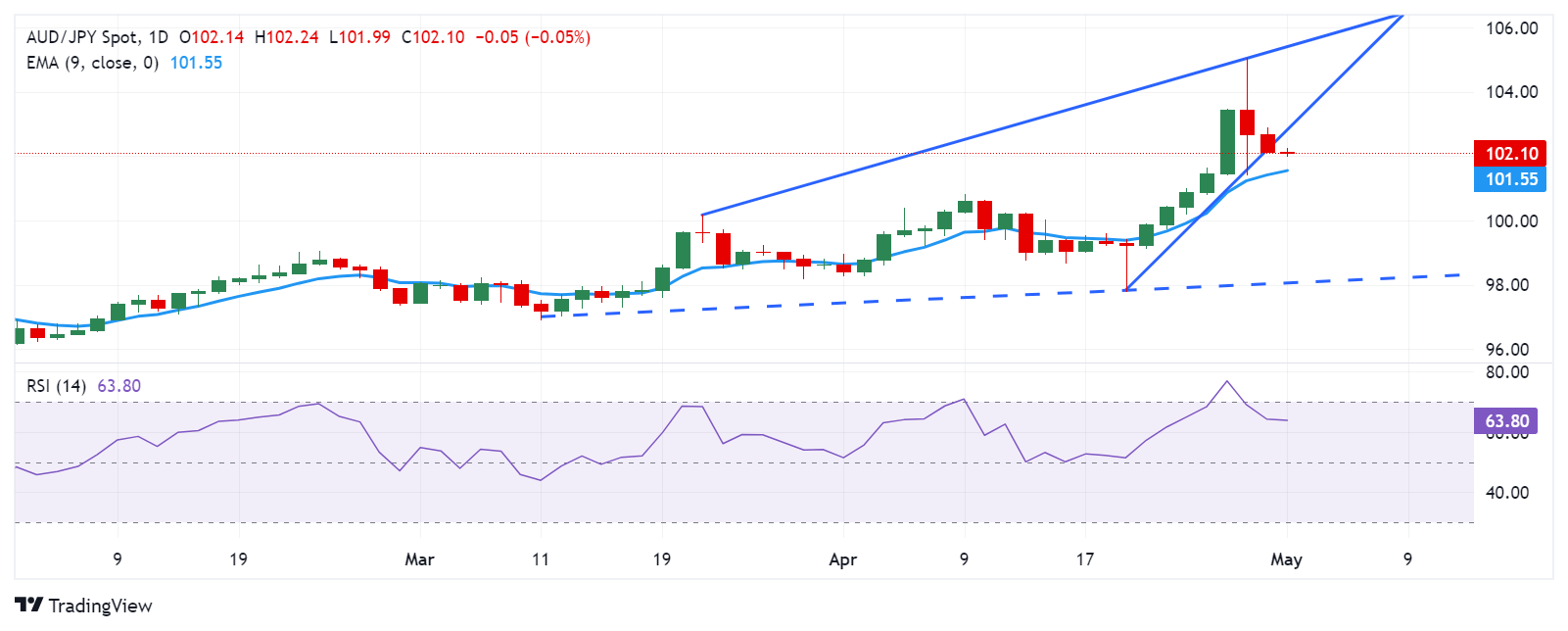- The Australian Dollar rebounds due to possible risk-on sentiment.
- The Australian Industry Index indicated prevailing contractionary conditions for the past twenty-four months.
- Following recent reports suggesting Tokyo's involvement in the currency market, traders will monitor for any Japanese intervention.
AUD/JPY snaps its two-day losing streak, possibly due to the improved risk appetite, hovering around 102.20. However, the Australian Dollar (AUD) faced pressure in Asian hours following the release of the AiG Industry Index on Wednesday, a leading indicator measuring private business activity in Australia, which continued its decline in March.
The softer Aussie Retail Sales released on Tuesday could potentially impact the Reserve Bank of Australia's (RBA) hawkish stance on interest rate trajectory. However, higher-than-expected domestic inflation data released last week raised expectations that the RBA may delay interest rate cuts. The central bank is scheduled to meet next week, and it is widely anticipated to maintain interest rates at the current level of 4.35%.
In Japan, market participants are closely monitoring for potential intervention following reports of Tokyo's involvement in the currency market on Monday, which boosted the Japanese Yen (JPY), according to Reuters. Additionally, expectations for a sustained significant interest rate differential between Japan and other nations suggest that the trajectory of the JPY is biased toward further depreciation.
The Bank of Japan (BoJ) is set to release its Monetary Policy Meeting Minutes on Thursday. These minutes provide insight into economic developments in Japan following the actual meeting. Changes in this report can influence JPY volatility.
Daily Digest Market Movers: AUD/JPY appreciates due to possible risk-on sentiment
- According to Reuters, the Sankei newspaper reported on Tuesday that Japan is considering implementing tax breaks for repatriation of corporate profits into the Yen. This measure may potentially be included in the annual mid-year policy blueprint.
- In April, the AiG Australian Industry Index declined by 3.6 points to reach -8.9 points, indicating prevailing contractionary conditions for the past twenty-four months. The previous reading was -5.3 in March.
- The benchmark ASX 200 opened lower on Wednesday, with all 11 sectors in the red. This decline followed hot US labor data that unsettled Wall Street, sparking concerns that persistent inflation may prompt the US Federal Reserve (Fed) to maintain higher interest rates for an extended period.
- As reported by the Financial Review, ANZ anticipates that the RBA will commence cutting interest rates in November, following last week’s stronger-than-expected inflation data. In a similar vein, Australia's largest mortgage lender, Commonwealth Bank, has adjusted its forecast for the timing of the first interest rate cut by the RBA. They are now projecting only one cut in November.
- The seasonally adjusted Australian Retail Sales released on Tuesday showed a drop in March, compared to the expected increase and the previous growth.
- Japan’s Retail Trade increased by 1.2% year-over-year in March, which was lower than the expected increase of 2.5% and the previous increase of 4.7%. The seasonally adjusted Retail Trade (MoM) decreased by 1.2%, against the expected rise of 0.6%.
- Masato Kanda, Japan's senior currency diplomat, made pointed comments regarding the currency's impact on import prices, emphasizing its significant influence. He highlighted the readiness of authorities to take action around the clock to address currency-related matters, as per a Reuters report.
- BoJ Governor Kazuo Ueda provided insights into the central bank's decision to maintain the status quo during the post-policy meeting press conference on Friday. Ueda outlined that the BoJ will adjust the degree of monetary easing if the underlying inflation rate rises.
Technical Analysis: AUD/JPY hovers around the psychological level of 102.00
The AUD/JPY traded around 102.10 on Wednesday, breaking below the lower boundary of a rising wedge pattern on the daily chart, which typically indicates a bearish reversal. This decline could weaken bullish sentiment; however, traders may await confirmation from the 14-day Relative Strength Index (RSI), which is still above the 50-level.
Immediate resistance is observed at the lower boundary of the wedge around the psychological level of 103.00. A rebound back into the ascending wedge could potentially improve the bullish sentiment and push the AUD/JPY pair toward the psychological level of 105.00, coinciding with the upper boundary of the wedge.
On the downside, immediate support for the AUD/JPY pair is seen at the psychological level of 102.00, followed by the nine-day Exponential Moving Average (EMA) at 101.56.
AUD/JPY: Daily Chart
Japanese Yen price today
The table below shows the percentage change of the Japanese Yen (JPY) against listed major currencies today. Japanese Yen was the weakest against the New Zealand Dollar.
| USD | EUR | GBP | CAD | AUD | JPY | NZD | CHF | |
| USD | 0.11% | 0.15% | 0.03% | 0.04% | 0.10% | -0.12% | 0.17% | |
| EUR | -0.12% | 0.03% | -0.08% | -0.08% | 0.00% | -0.23% | 0.07% | |
| GBP | -0.15% | -0.04% | -0.11% | -0.11% | -0.05% | -0.26% | 0.04% | |
| CAD | -0.02% | 0.09% | 0.12% | 0.02% | 0.07% | -0.15% | 0.14% | |
| AUD | -0.04% | 0.08% | 0.10% | 0.00% | 0.05% | -0.15% | 0.14% | |
| JPY | -0.09% | 0.02% | 0.04% | -0.07% | -0.05% | -0.22% | 0.10% | |
| NZD | 0.13% | 0.24% | 0.27% | 0.16% | 0.17% | 0.23% | 0.29% | |
| CHF | -0.18% | -0.06% | -0.03% | -0.14% | -0.13% | -0.12% | -0.29% |
The heat map shows percentage changes of major currencies against each other. The base currency is picked from the left column, while the quote currency is picked from the top row. For example, if you pick the Euro from the left column and move along the horizontal line to the Japanese Yen, the percentage change displayed in the box will represent EUR (base)/JPY (quote).
Bank of Japan FAQs
The Bank of Japan (BoJ) is the Japanese central bank, which sets monetary policy in the country. Its mandate is to issue banknotes and carry out currency and monetary control to ensure price stability, which means an inflation target of around 2%.
The Bank of Japan has embarked in an ultra-loose monetary policy since 2013 in order to stimulate the economy and fuel inflation amid a low-inflationary environment. The bank’s policy is based on Quantitative and Qualitative Easing (QQE), or printing notes to buy assets such as government or corporate bonds to provide liquidity. In 2016, the bank doubled down on its strategy and further loosened policy by first introducing negative interest rates and then directly controlling the yield of its 10-year government bonds.
The Bank’s massive stimulus has caused the Yen to depreciate against its main currency peers. This process has exacerbated more recently due to an increasing policy divergence between the Bank of Japan and other main central banks, which have opted to increase interest rates sharply to fight decades-high levels of inflation. The BoJ’s policy of holding down rates has led to a widening differential with other currencies, dragging down the value of the Yen.
A weaker Yen and the spike in global energy prices have led to an increase in Japanese inflation, which has exceeded the BoJ’s 2% target. Still, the Bank judges that the sustainable and stable achievement of the 2% target has not yet come in sight, so any sudden change in the current policy looks unlikely.
Information on these pages contains forward-looking statements that involve risks and uncertainties. Markets and instruments profiled on this page are for informational purposes only and should not in any way come across as a recommendation to buy or sell in these assets. You should do your own thorough research before making any investment decisions. FXStreet does not in any way guarantee that this information is free from mistakes, errors, or material misstatements. It also does not guarantee that this information is of a timely nature. Investing in Open Markets involves a great deal of risk, including the loss of all or a portion of your investment, as well as emotional distress. All risks, losses and costs associated with investing, including total loss of principal, are your responsibility. The views and opinions expressed in this article are those of the authors and do not necessarily reflect the official policy or position of FXStreet nor its advertisers. The author will not be held responsible for information that is found at the end of links posted on this page.
If not otherwise explicitly mentioned in the body of the article, at the time of writing, the author has no position in any stock mentioned in this article and no business relationship with any company mentioned. The author has not received compensation for writing this article, other than from FXStreet.
FXStreet and the author do not provide personalized recommendations. The author makes no representations as to the accuracy, completeness, or suitability of this information. FXStreet and the author will not be liable for any errors, omissions or any losses, injuries or damages arising from this information and its display or use. Errors and omissions excepted.
The author and FXStreet are not registered investment advisors and nothing in this article is intended to be investment advice.
Recommended content
Editors’ Picks

EUR/USD stays below 1.0550 after soft German inflation data
EUR/USD trades in negative territory slightly below 1.0550 on Thursday. Soft inflation data from Germany makes it difficult for the Euro to gather strength, causing the pair to stretch lower. US markets will remain closed in observance of the Thanksgiving Day holiday.

GBP/USD trades below 1.2700 on modest USD recovery
GBP/USD stays under modest bearish pressure and fluctuates below 1.2700 on Thursday. The US Dollar corrects higher following Wednesday's sharp decline, not allowing the pair to gain traction. The market action is likely to remain subdued in the American session.

Gold maintains shallow recovery on Fed rate-cut bets
Gold extends its shallow recovery from Tuesday’s lows as it trades in the $2,640s on Thursday. The yellow metal is seeing gains on the back of cementing market bets that the Fed will go ahead and cut US interest rates at its December meeting.

Fantom bulls eye yearly high as BTC rebounds
Fantom (FTM) continued its rally and rallied 8% until Thursday, trading above $1.09 after 43% gains in the previous week. Like FTM, most altcoins have continued the rally as Bitcoin (BTC) recovers from its recent pullback this week.

Eurozone PMI sounds the alarm about growth once more
The composite PMI dropped from 50 to 48.1, once more stressing growth concerns for the eurozone. Hard data has actually come in better than expected recently – so ahead of the December meeting, the ECB has to figure out whether this is the PMI crying wolf or whether it should take this signal seriously. We think it’s the latter.

Best Forex Brokers with Low Spreads
VERIFIED Low spreads are crucial for reducing trading costs. Explore top Forex brokers offering competitive spreads and high leverage. Compare options for EUR/USD, GBP/USD, USD/JPY, and Gold.
